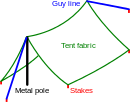
Camping is a form of outdoor recreation involving overnight stays with a basic temporary shelter such as a tent. Camping can also include a recreational vehicle, a permanent tent, a shelter such as a bivy or tarp, or no shelter at all. Typically, participants leave developed areas to spend time outdoors, in pursuit of activities providing them enjoyment or an educational experience. Spending the night away from home distinguishes camping from day-tripping, picnicking, and other outdoor activities.

A tent is a shelter consisting of sheets of fabric or other material draped over, attached to a frame of poles or a supporting rope. While smaller tents may be free-standing or attached to the ground, large tents are usually anchored using guy ropes tied to stakes or tent pegs. First used as portable homes by nomads, tents are now more often used for recreational camping and as temporary shelters.
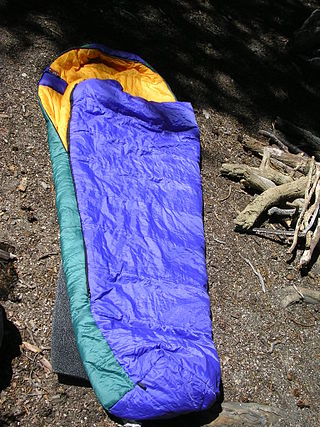
A sleeping bag is an insulated covering for a person, essentially a lightweight quilt that can be closed with a zipper or similar means to form a tube, which functions as lightweight, portable bedding in situations where a person is sleeping outdoors. It is also commonly used indoors for people who do not have beds or at sleepovers for when one or more persons cannot all fit in the bed or do not feel comfortable sleeping with someone. Its primary purpose is to provide warmth and thermal insulation through its synthetic or down insulation. It also typically has a water-resistant or water-repellent cover that protects, to some extent, against wind chill and light precipitation, but a tent is usually used in addition to a sleeping bag, as it performs those functions better. The bottom surface also provides some cushioning, but a sleeping pad or camp cot is usually used in addition for that purpose. The bottom surface of a sleeping bag may be moderately water repellent, but a plastic tarp or groundsheet is often used to protect against moist ground.

In camping, a ground pad, sleeping pad, thermal pad, sleeping mat, or roll mat is lightweight pad, common among hikers, backpackers and budget travelers, often used in conjunction with a sleeping bag. Its purpose is to provide padding and thermal insulation. All types currently available use air as their primary form of insulation.

Outdoor cooking is the preparation of food in the outdoors. A significant body of techniques and specialized equipment exists for it, traditionally associated with nomadic cultures such as the Berbers of North Africa, the Arab Bedouins, the Plains Indians, pioneers in North America, and indigenous tribes in South America. These methods have been refined in modern times for use during recreational outdoors pursuits, by campers and backpackers.

A hammock is a sling made of fabric, rope, or netting, suspended between two or more points, used for swinging, sleeping, or resting. It normally consists of one or more cloth panels, or a woven network of twine or thin rope stretched with ropes between two firm anchor points such as trees or posts. Hammocks were developed by native inhabitants of the Americas for sleeping, as well as the English. Later, they were used aboard ships by sailors to enable comfort and maximize available space, by explorers or soldiers travelling in wooded regions and eventually by parents in the early 1920s for containing babies just learning to crawl. Today they are popular around the world for relaxation; they are also used as a lightweight bed on camping trips. The hammock is often seen as a symbol of summer, leisure, relaxation and simple, easy living.

A tarpaulin or tarp is a large sheet of strong, flexible, water-resistant or waterproof material, often cloth such as canvas or polyester coated with polyurethane, or made of plastics such as polyethylene. Tarpaulins often have reinforced grommets at the corners and along the sides to form attachment points for rope, allowing them to be tied down or suspended.

Backpacking is the outdoor recreation of carrying gear on one's back, while hiking for more than a day. It is often an extended journey, and may involve camping outdoors. In North America tenting is common, where simple shelters and mountain huts, widely found in Europe, are rare. In New Zealand, hiking is called tramping and tents are used alongside a nationwide network of huts. Hill walking is an equivalent in Britain, though backpackers make use of a variety of accommodation, in addition to camping. Backpackers use simple huts in South Africa. Trekking and bushwalking are other words used to describe such multi-day trips.
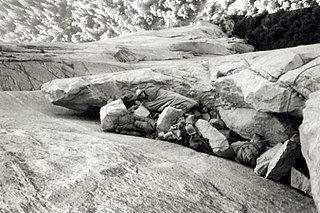
A bivouac shelter or bivvy is any of a variety of improvised camp site, or shelter that is usually of a temporary nature, used especially by soldiers, or people engaged in backpacking, bikepacking, scouting, or mountain climbing. It may often refer to sleeping in the open with a bivouac sack, but it may also refer to a shelter constructed of natural materials like a structure of branches to form a frame, which is then covered with leaves, ferns, and similar material for waterproofing and duff for insulation. Modern bivouacs often involve the use of one- or two-man tents but may also be without tents or full cover. In modern mountaineering the nature of the bivouac shelter will depend on the level of preparedness, in particular whether existing camping and outdoor gear may be incorporated into the shelter.

A fly refers to the outer layer of a tent or to a piece of material which is strung up using rope as a minimalist, stand-alone shelter. In basic terms, a fly is a tent without walls. Purpose-made stand-alone flies are also sometimes referred to as bivouacs, bivvies, tarpaulins, or hootchies. Flies are generally used for keeping moisture or sun off people while they eat, rest or sleep. They can also be used as groundsheets, but this is not recommended since it creates wear and tear which can lead to holes.

A portaledge is a deployable hanging tent system designed for rock climbers who spend multiple days and nights on a big wall climb. An assembled portaledge is a fabric-covered platform surrounded by a metal frame that hangs from a single point and has adjustable suspension straps. A separate cover, called a stormfly, covers the entire system in the event of bad weather.

Ultralight backpacking is a subset of lightweight backpacking, a style of backpacking which emphasizes carrying the lightest and least amount of gear. While no technical standards exist, some United States hikers consider "ultralight" to mean an initial base weight of less than 4.5kg. Base weight is the weight of a fully loaded backpack at the start of a trip, plus the gear inside and outside it, excluding consumables such as food, water, and fuel. Base weight can be lowered by reducing the weight of individual items of gear, or by choosing not to carry that gear. Ultralight backpacking is most popular among thru-hikers—those hikers on extended trips requiring resupply.
Hiking equipment is the equipment taken on outdoor walking trips. Hiking is usually divided into day-hikes and multiple-day hikes, called backpacking, trekking, and walking tours.

A tarp tent is a tarpaulin, a plastic or nylon sheet, used in place of a tent. It is usually rigged with poles, tent pegs, and guy lines. Ultralight backpackers use tarp tents because they are lightweight compared to other backpacking shelters.

Fastpacking is a combination of trail running and ultralight backpacking: "hiking the ups, jogging the flats, and running the downs," depending on the gradient, because of the weight carried. Participants carry a light pack with essential supplies, including a sleeping bag and tent, or similar form of shelter, if mountain huts or other accommodation is not available. The weight carried will vary but fastpackers aim at no more than 15 pounds (6.8 kg) and some achieve less than 10 pounds (4.5 kg). This activity may be undertaken either unsupported, self-supported, or supported. "Unsupported fastpackers make no use of outside assistance along the route", while self-supported fastpackers will leave caches of supplies along the intended route.

A loue is an ultra-light Finnish open tent-like shelter. It is used to give reasonable protection from wind and rain during a variety of outdoor activities, including camping, canoeing, hiking and hunting. Loues are popular with Scout groups and minimalist campers. Suitable as one or two person shelters, they are compact, light and can be set up and taken down in a basic way fairly quickly. The workman-like sets shown in photographs indicate that more effort can be made to stiffen the sides and the stakes and lines used can complicate a taut setup. The open front permits fire viewing, ventilation and looking out over a scenic view. A loue consists of a roughly conical section of fabric with the semi-circular bottom edge grounded by stakes and the tip raised with a single pole. Suitable standing tree trunks may be used to suspend the tent if an open campfire is not to be used. This style of ''tarp tent" can best be raised using a scissors-pole assembly. A pole suspension system allows for positioning an open fire in front of the shelter without the risk of damaging tree trunks or roots. The panels of a true Finnish loue are designed to provide a semi-circular short wall around the shelter and a triangular piece at the tip can be let down to provide a little more shelter in front. With suitable siting and careful staking and tensioning, the side walls can be set close to the ground, providing protection from drafts and lifting from winds.
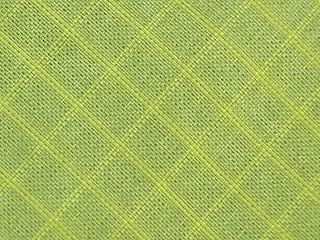
Ripstop fabrics are woven fabrics, often made of nylon, using a reinforcing technique that makes them more resistant to tearing and ripping. During weaving, stronger reinforcement yarns are interwoven at regular intervals in a crosshatch pattern. The intervals are typically 5 to 8 millimeters. Thin and lightweight ripstop fabrics have a 2-dimensional structure due to the thicker yarns being interwoven in thinner cloth. Older lightweight ripstop fabrics display the thicker interlocking thread patterns in the material quite prominently, but more modern weaving techniques make the ripstop threads less obvious. A similar effect can be achieved by weaving two or three fine yarns together at smaller intervals.

A pop-up camper is a type of towed recreational vehicle that can be collapsed for easy storage and transport. When set up, this type of trailer provides a large amount of interior space when compared to its size when collapsed. Its relatively affordable price makes it a popular choice for some RVers and its small size contributes to easier towing than many other types of RVs.

A tree tent is a camping tent designed to be set above the ground, usually attached to or supported by the neighboring trees. Like a tent, it must be a complete enclosure that can house a camper and their gear while suspended off the ground. Like tree houses, a tree tent may be accessed via a rope ladder and provide a sheltered environment for recreation and various outdoor activities. The portable nature of this type of shelter provides for more versatile location choice than a conventional tree house or a camping tent.
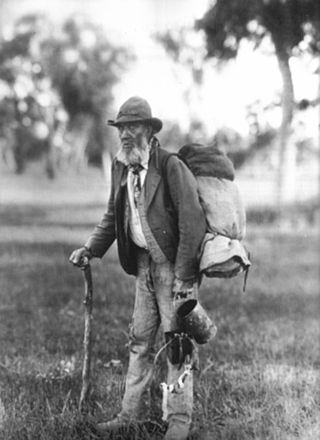
The cowboy bedroll was an American Old West precursor to the modern sleeping bag, which carried a man's bed and some personal belongings in a waterproof shell. In Australia, it was called a swag.






















